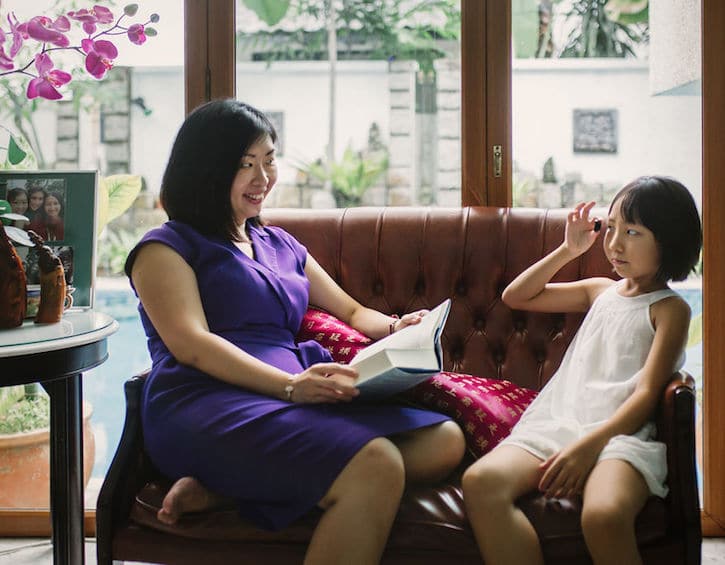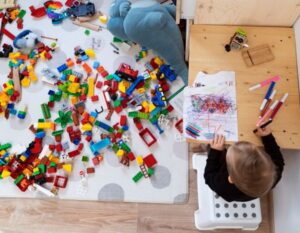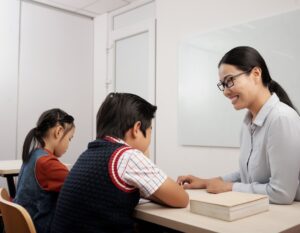
We hear from educational experts on how to keep kids healthy and motivated (and parents sane!) during home-based learning
Our first dive into Home-Based Learning (HBL) last year was a steep learning curve for everyone – students, teachers, parents, and school administrators. A few things have become clear since: teachers are incredible (and most of us could never in a million years do their job, even if we weren’t already doing our own jobs), and it is neither possible, nor practical, to replicate exactly how in-class teaching is done online, especially for very young kids – which is why we are so grateful the option is now open this year for many in early years to stay at preschool.
But how can older kids make the most out of their home-based learning experience? One recurring piece of advice we received from all the educators below is to embrace the positives of staying home more such as increased family bonding and the ability to get more sleep.
Last year during the Circuit Breaker we talked to educators from four leading Singapore international schools to get their input on tips on getting the best out of home learning but today during phase 2 (HA) much of their advice is still useful.
Our panel:
- Christian Soulard, Principal of the International French School Singapore (IFS, formerly Lyçee Français)
- Nicholas Duggan, Principal of Invictus International School
- Michelle Dickinson, Head of School at One World International School (OWIS)
- Claire Holmes, Head of School Counselling at Tanglin Trust School
Remember WHY there’s Home-Based Learning in the first place
No matter your kids’ age, it doesn’t hurt to remind them that we are practicing our community responsibility to stop the virus spreading, says Claire Holmes from Tanglin. Remind them that “Everyone at school is helping each other at the moment, staying at home will help us to stay healthy.” When they’re missing their friends and teachers, it helps to reassure them that even though we are not physically together, our community is united in staying safe.
While learning motivation usually comes from teachers and peers at school, parents must now take on the responsibility to engage their children and be invested in the learning process. But they need to strike a necessary balance here – keep things fun. Don’t make children dread their home-based learning experience, says Christian Soulard of IFS.
There’s a Home-Based Learning Curve for Teachers, too
The main distinction between in-person and home-based learning, says Christian Soulard, is the students’ learning environment. From a teacher’s perspective, this is also the most significant challenge – and it has to be said that it is not possible or practical to replicate precisely how teaching is done in class online.
“From classroom management to available learning tools, this has forced teachers to adapt their teaching style, how they approach students, the subject matter, and how to capture students’ attention. We understand that it is an adjustment and learning journey for both teachers and students,” he says.
For instance, IFS has relied on a robust structured approach to provide critical continuity of education, while also employing a combination of visual content, independent learning, quizzes and more as learning tools. Teachers have seen the need to get extra creative – particularly with younger kids – from using green-screen visuals and incorporating more hands-on activities, to sharing jokes and funny stories to keep spirits high.
Accepting imperfection – from ourselves, and from others – is a key to overcoming the stress of HBL, says Nicholas Duggan from Invictus:
“There is often a mistaken assumption, especially amongst adults working from home, that somehow, it is easier – as a result, we work harder than we would in the workplace. This is true for children too. Whether you are working or your child is studying, make no mistake – it is hard. Although HBL is not new, pursuing HBL during a crisis is. We are all learning together, new ways to function. It’s OK not to get it right every time – for you or your child.”

Learning Need Not Be Linear
Parents should remember that learning doesn’t happen in a straight line and that their children’s education is a continuous journey, says Christian Soulard. “Give them the chance to make mistakes and advise them on what went wrong so that they can learn from them.”
Adds Claire Holmes,
“Notice what’s working for you and your children and do more of it. Spot times when you notice your kids co-operating, supporting each other and compliment them. When ‘bumps in the road’ present themselves, know that these are moments of learning about how to co-exist peacefully in this new set up. Be compassionate with yourself and know that it doesn’t all have to be perfect. There will be plenty of teachable moments when you can ask yourself ‘What can we learn from this?’ Reflecting in this way helps you to navigate these ‘bumps.’
Ultimately, says Nicholas Duggan, setting achievable goals – and keeping teachers in the loop about what is and is not manageable – will go a long way toward maintaining sanity:
“One of the risks of HBL is that students (and parents) feel overloaded with work. Sometimes assignments that should take a few minutes may take a lot longer – make sure that you feel the goals are achievable in a reasonable time limit for your child. If not, set what goal is realistic and inform the teacher. Remember, HBL is about learning – it’s not a race!”
Establish a routine – and take routine breaks
When spending time at home with their children, parents should encourage and practise taking regular breaks with their children, says Michelle Dickinson of OWIS. One simple way to start is through regular breathing breaks, by getting children to close their eyes and take note of the number of breaths they take in a minute.
This simple practice has been proven to reduce the heart rate and calm the part of the brain which processes emotions, and can be practised anywhere to help lower levels of stress and anxiety.
In order to promote structure, Nicholas Duggan suggests having a designated study space (“not near the TV or comfy couch!”), getting dressed for school, and setting specific study hours (and then sticking to them!). It’s just as important to have post-study plans, whether it’s getting chores done, reading a good book, or playing a family board game.
Read more: Organising your space for home-based learning
Explore the benefits of Mindfulness, for kids and adults
Michelle Dickinson of OWIS is a big advocate for mindfulness and meditation, which are built into the school’s curriculum. “During this time where we find ourselves surrounded by an onslaught of news and updates on the Covid-19 pandemic, and as parents now find themselves having to juggle children’s home-based learning curricula on top of their regular workload – all under the same roof – it is understandable that levels of stress and frustration may skyrocket during this period.
“While inevitable, there are definitely ways to manage and lessen the impact of these emotions. Mindfulness plays a key role in helping both parents and children increase emotional regulation and self-control, lower stress levels, and improve clarity and focus.”
Practising mindfulness “allows us to free our minds from negative thoughts, and develop the habit of fostering positive thoughts, which helps in managing anxiety and building emotional resilience over time,” she explains.
OWIS does this by incorporating practises like traditional meditation and concentration-based movements, such as yoga and tai chi into the curriculum. These activities help to strengthen children’s social and emotional intelligence. Ms. Dickinson encourages parents to incorporate these at home as well, to help children stay calm and focused amid stressful situations.
Not sure where to start when you’re stuck at home? Check out our guide to mindfulness and meditation apps for kids and adults!

Make time for screen-free bonding
Claire Holmes advises weaving family bonding activities like menu planning and cooking together, collectively reading a book, or doing yoga into your daily routine. You could create a “learning from home” playlist on Spotify together, or work together watering or pruning plants on your balcony or in your garden.
Both parents and children should be sure to set aside digital devices for a period after work and learning each day, says Michelle Dickinson, so as to connect with each other through meaningful connection and cut down on screen time and exposure to news and social media feeds. By taking this time to reconnect and enjoy simple family pleasures, she explains, parents and children can make this period a less stressful one, and also enhance both physical and emotional well-being.
In addition to about two daily hours of home-based learning geared toward core subjects like languages and Math, IFS makes sure to provide students with optional screen-free reading activities and creative projects. At 5pm each day its P.E. team even organises online group activities, which have the dual benefit of getting students moving and providing the opportunity for the school community to come together as a whole. Even parents are getting in on the fun!
Don’t panic about too much screen time either, though
It’s important to remember the importance of doing things that make you feel good, says Claire Holmes. For kids this might be meditation or journaling, or perhaps it’s video games. And of course, connection is a human need, so it’s worthwhile encouraging kids to video chat with their friends, or with relatives, on a regular basis throughout the week. It’s good for you to do it too, mama!

What kids can learn from this unique and challenging experience
“At OWIS we believe that children are never too young to learn and practise mindfulness, as it helps to set them up for both long-term personal and professional success,” says Michelle Dickinson. This is a unique opportunity for young, impressionable years children to “learn the importance of staying present in the moment and thinking calmly, taking time to reflect and recognise that they can make positive choices when interacting with others or the world at large.”
According to Christian Soulard of IFS, home-based learning has provided the opportunity to continually encourage and guide students to be adaptable, think positively and make the most out of a situation to emerge stronger – intellectually and also, on a personal level.
Concludes Nicholas Duggan of Invictus (which has just launched an interactive home-based learning site at www.invictus.family):
“Be good to yourself. Allocate time for yourself and for your loved ones. Try to find small slots to maintain relationships and treat yourself and your child to something you both enjoy.”
Normalise, validate and empathise with whatever emotions your kids are feeling, says Claire Holmes. They may even feel a sense of anger about lost opportunities socially or at school. Try having a family ‘check in’ to hear what’s working and what’s challenging. You might weave in positive things that you have noticed about each other, share things that each family member feels thankful for.
Ultimately, “this situation may afford you the opportunity to look at what’s important for your family, to find some grace, emotional generosity and kindness with each other that will strengthen the family unit moving forward.”
Click here for more Home-Based Learning tips in our Ultimate Circuit Breaker Survival Guide!






 View All
View All





 View All
View All









 View All
View All



![[𝗦𝗔𝗩𝗘 𝗧𝗛𝗜𝗦] 𝗞𝗶𝗱-𝗔𝗽𝗽𝗿𝗼𝘃𝗲𝗱 𝗗𝗲𝘀𝘀𝗲𝗿𝘁 𝗦𝗽𝗼𝘁𝘀 𝗬𝗼𝘂 𝗖𝗮𝗻 ‘𝗘𝗮𝘁 𝗳𝗼𝗿 𝗙𝗿𝗲𝗲’ 𝗪𝗶𝘁𝗵 𝗖𝗗𝗖 𝗩𝗼𝘂𝗰𝗵𝗲𝗿𝘀! 🍦🍩🧁😉
Before you ask “Can use CDC voucher?” Yes, you definitely can! These spots are perfect for an after-school treat, weekend fun, or just saying “yes” to dessert without saying goodbye to your wallet.
Comment “Sweet” or tap the link in bio for more foodie recommendations!
Got a fave kid-friendly spot that accepts CDC vouchers? Let us know in the comments too!
.
.
.
.
.
.
.
#CDCVouchersSG #SGMumLife #KidFriendlySG #FreeDessert #HeartlandEats #SweetTreatsSG #SGParents #FamilyFunSG #WafflesAndIceCream #BudgetParenting #ThingsToDoWithKidsSG #SGCafes #SupportLocalSG #KidsEatHappy #CDCAdventures](https://www.sassymamasg.com/wp-content/plugins/instagram-feed/img/placeholder.png)
